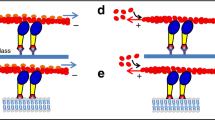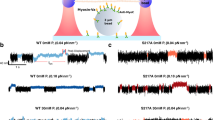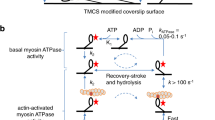Abstract
Recent studies provide strong evidence that single myosin class V molecules transport vesicles and organelles processively along F-actin, taking several 36-nm steps, 'hand over hand', for each diffusional encounter. The mechanisms regulating myosin-V's processivity remain unknown. Here, we have used an optical-tweezers-based transducer to measure the effect of load on the mechanical interactions between rabbit skeletal F-actin and a single head of mouse brain myosin-V, which produces its working stroke in two phases. We found that the lifetimes of the first phase of the working stroke changed exponentially and about 10-fold over a range of pushing and pulling forces of ± 1.5 pN. Stiffness measurements suggest that intramolecular forces could approach 3.6 pN when both heads are bound to F-actin, in which case extrapolation would predict the detachment kinetics of the front head to slow down 50-fold and the kinetics of the rear head to accelerate respectively. This synchronizing effect on the chemo-mechanical cycles of the heads increases the probability of the trail head detaching first and causes a strong increase in the number of forward steps per diffusional encounter over a system with no strain dependence.
This is a preview of subscription content, access via your institution
Access options
Subscribe to this journal
Receive 12 print issues and online access
$209.00 per year
only $17.42 per issue
Buy this article
- Purchase on Springer Link
- Instant access to full article PDF
Prices may be subject to local taxes which are calculated during checkout





Similar content being viewed by others
Accession codes
References
Reck-Peterson, S., Provance, D. W., Mooseker, M. S. & Mercer, J. A. Review: Class V myosins. Biochim. Biophys. Acta 1496, 36–51 (2000).
Sellers, J. R. Myosins (Oxford University Press, Oxford, 1999).
Cheney, R. E. et al. Brain Myosin-V is a two-headed unconventional myosin with motor activity. Cell 75, 13–23 (1993).
Miller, E. & Sheetz, M. P. Characterization of myosin-V binding to brain vesicles. J. Biol. Chem. 275, 2598–2606 (2000).
Vale, R. D. Myosin V motor proteins: marching stepwise towards a mechanism. J. Cell Biol. 163, 445–450 (2003).
Mehta, A. D. et al. Myosin-V is a processive actin-based motor. Nature 400, 590–593 (1999).
Rief, M. et al. Myosin-V stepping kinetics: A molecular model for processivity. Proc. Natl Acad. Sci. 97, 9482–9486 (2000).
Sakamoto, T., Amitani, I., Yokota, E. & Ando, T. Direct observation of processive movement by individual myosin-V molecules. Biochem. Biophys. Res. Comm. 272, 586–590 (2000).
Sakamoto, T. et al. Neck length and processivity of myosin-V. J. Biol. Chem. 278, 29201–29207 (2003).
Yildiz, A. et al. Myosin-V walks hand over hand: single fluorophore imaging with 1.5nm localisation. Science 300, 2061–2065 (2003).
Forkey, J. N., Quinlan, M. E., Shaw, M. A., Corrie, J. E. & Goldman, Y. E. Three dimensional structural dynamics of myosin-V by single-molecule fluorescence polarisation. Nature 422, 399–404 (2003).
Walker, M. et al. Two-headed binding of a processive myosin to F-actin. Nature 405, 804–807 (2000).
Veigel, C., Wang, F., Bartoo, M. L., Sellers, J. R. & Molloy, J. E. The gated gait of the processive molecular motor myosin-V. Nature Cell Biol. 4, 59–65 (2002).
Ali, M. Y. et al. Myosin-V is a left-handed spiral motor on the right-handed actin helix. Nature Struct. Biol. 9, 464–467 (2002).
Tanaka, H. et al. The motor domain determines the large step of myosin V. Nature 415, 192–195 (2002).
Schnitzer, M. J. & Block, S. M. Statistical kinetics of processive enzymes. Cold Spring Harb. Symp. Quant. Biol. 60, 793–802 (1995).
Kolomeisky, A. B. & Fisher, M. E. A simple kinetic model describes the processivity of myosin-V. Biophys. J. 84, 1642–1650 (2003).
Lan, G. & Sun, S. X. Dynamics of myosin processivity. Biophys. J. 88, 4107–4117 (2005).
Coureux, P. D., Sweeney, H. L. & Houdusse, A. Three myosin-V structures delineate essential features of chemo-mechanical transduction. EMBO J. 23, 4527–4537 (2004).
Purcell, T. J., Morris, C., Spudich, J. A. & Sweeney, H. L. Role of the lever arm in the processive stepping of myosin-V. Proc. Natl Acad. Sci. USA 92, 14159–14164 (2002).
Huxley, A. F. Muscle structure and theories of contraction. Progr. Biophys. Biophys. Chem. 7, 255–318 (1957).
De La Cruz, E. M., Wells, A. L., Rosenfeld, S. S., Ostap, E. M. & Sweeney, H. L. The kinetic mechanism of myosin-V. Proc. Natl Acad. Sci. 96, 13726–13731 (1999).
Baker, J. E. et al. Myosin-V processivity: multiple kinetic pathways for head-to-head coordination. Proc. Natl Acad. Sci. USA 101, 5542–5546 (2004).
Clemen, A. E. et al. Force dependent stepping kinetics of myosin-V. Biophys. J. 88, 4402–4410 (2005).
Moore, J. R., Krementsova, E. B., Trybus, K. M. & Warshaw, D. M. Myosin-V exhibits a high duty cycle and large unitary displacement. J. Cell Biol. 155, 625–635 (2001).
Uemura, S., Higuchi, H., Olivares, A. O., DeLaCruz, E. M. & Ishiwata, S. Mechanochemical coupling of two substeps in a single myosin-V motor. Nature Struct. Biol. 11, 877–883 (2004).
Rosenfeld, S. S. & Sweeney, H. L. A model for myosin-V processivity. J. Biol. Chem. 279, 40100–40111 (2004).
Molloy, J. E., Burns, J. E., Kendrick-Jones, J., Tregear, R. T. & White, D. C. S. Movement and force produced by a single myosin head. Nature 378, 209–212 (1995).
Veigel, C., Bartoo, M. L., White, D. C. S, Sparrow, J. C. & Molloy, J. E. The stiffness of rabbit skeletal, acto-myosin crossbridges determined with an optical tweezers transducer. Biophys. J. 75, 1424–1438 (1998).
Wang, F. et al. Effect of ADP and ionic strength on the kinetic and motile properties of recombinant mouse myosin-V. J. Biol. Chem. 275, 4329–4335 (2000).
Veigel, C. et al. The motor protein myosin-I produces its working stroke in two steps. Nature 398, 530–533 (1999).
Veigel, C., Molloy, J. E., Schmitz, S. & Kendrick-Jones, J. Load-dependent kinetics of force production by smooth muscle myosin measured with optical tweezers. Nature Cell Biol. 5, 980–986 (2003).
Howard, J. Mechanics of Motor Proteins and the Cytoskeleton (Sinauer Associates, Inc., Sunderland, 2001).
Lymn, R. W. & Taylor, E. W. Mechanism of adenosine triphosphate hydrolysis by acto-myosin. Biochemistry 10, 4617–4624 (1971).
Burgess, S. et al. The prepower stroke conformation of myosin-V. J. Cell Biol. 159, 983–991 (2002).
Whittaker, M. et al. A 35-Å movement of smooth muscle myosin on ADP release. Nature 378, 748–751 (1995).
Berger, C. E. M, Fagnant, P. M., Heizmann, S., Trybus, K. M. & Geeves, M. A. ADP binding induces and asymmetry between the heads of unphosphorylated myosin J. Biol. Chem. 276, 23240–23245 (2001).
Lombardi, V. et al. Elastic distortion of the myosin head and repriming of the working stroke in muscle. Nature 374, 553–555 (1995).
Cheney, R. E. Purification and assay of myosin-V. Methods Enzymol. 298, 3–18 (1998).
Mehta, A. D., Finer, J. T. & Spudich, J. A. Stiffness of muscle myosin. Detection of single-molecule interactions using correlated thermal diffusion. Proc. Natl Acad. Sci. USA 94, 7927–7931 (1997).
Tyska, M. J. et al. Two heads of myosin are better than one for generating force and motion. Proc. Natl. Acad. Sci. USA 96, 4402–4407 (1999).
Acknowledgements
We thank E. Harvey for technical assistance, J. A. Hammer III for kindly supplying the MV clone, J. E. Molloy, J. Howard and M. A. Geeves for helpful discussions and critical reading of the manuscript, and MRC, The Royal Society, BBSRC and NIH for grant support.
Author information
Authors and Affiliations
Corresponding author
Ethics declarations
Competing interests
The authors declare no competing financial interests.
Rights and permissions
About this article
Cite this article
Veigel, C., Schmitz, S., Wang, F. et al. Load-dependent kinetics of myosin-V can explain its high processivity. Nat Cell Biol 7, 861–869 (2005). https://doi.org/10.1038/ncb1287
Received:
Accepted:
Published:
Issue Date:
DOI: https://doi.org/10.1038/ncb1287
This article is cited by
-
Expression of hypoxia-inducible genes is suppressed in altered gravity due to impaired nuclear HIF1α accumulation
Scientific Reports (2023)
-
Storage of mechanical energy in DNA nanorobotics using molecular torsion springs
Nature Physics (2023)
-
A mutation in switch I alters the load-dependent kinetics of myosin Va
Nature Communications (2023)



